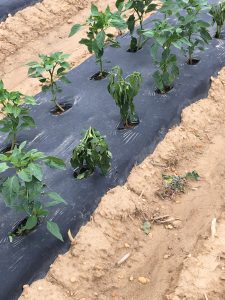Sweet Corn
Low numbers of European corn borer (ECB) moths continue to be captured, with little change from the previous week. We anticipate that this initial flight is nearing its’ end. The highest adult activity is currently Gloucester County (see map below at right). Whorl corn is the primary target for egg laying, and injury as high as 40% of plants infested has been found in Hunterdon County this week. This high feeding percentage is an outlier relative to what scouts are typically finding this season. Most infestations are in the single-to- mid teens in terms of plants infested. It is typical for feeding percentages to rise as the moth catch declines. We expect feeding to increase for the next 1-2 weeks before peaking.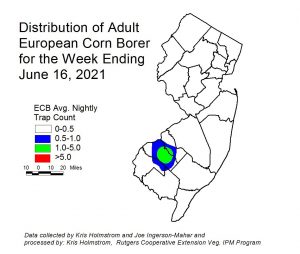
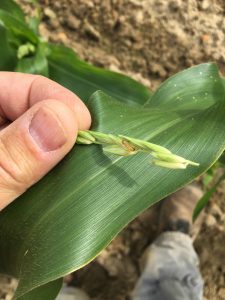 Look for the characteristic “shot-hole” type of feeding (photo below at right) and consider treating when infested plants exceed 12% in a 50 plant sample. As plantings proceed to the pre-tassel stage, ECB larvae may be found in emerging tassels (see photo at left). It is a good idea to treat individual plantings as they move into the full tassel/first silk stage one time. This eliminates any ECB larvae that have emerged with the tassels as they begin to move down the stalk to re-enter near developing ears.
Look for the characteristic “shot-hole” type of feeding (photo below at right) and consider treating when infested plants exceed 12% in a 50 plant sample. As plantings proceed to the pre-tassel stage, ECB larvae may be found in emerging tassels (see photo at left). It is a good idea to treat individual plantings as they move into the full tassel/first silk stage one time. This eliminates any ECB larvae that have emerged with the tassels as they begin to move down the stalk to re-enter near developing ears.
Useful insecticides for this particular application include synthetic 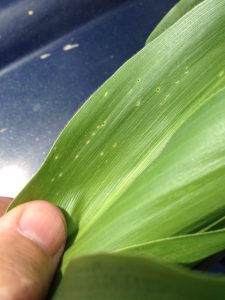 pyrethroids (IRAC Grp 3), spinosyns (including OMRI approved Entrust) IRAC Grp 5), and diamides such as Coragen or Vantacor (IRAC Grp 28) or materials such as Besiege which include the active ingredient in Coragen. Synthetic pyrethroids alone should NOT be used for corn earworm (CEW) protection on silking corn. Control with these materials is very inconsistent.
pyrethroids (IRAC Grp 3), spinosyns (including OMRI approved Entrust) IRAC Grp 5), and diamides such as Coragen or Vantacor (IRAC Grp 28) or materials such as Besiege which include the active ingredient in Coragen. Synthetic pyrethroids alone should NOT be used for corn earworm (CEW) protection on silking corn. Control with these materials is very inconsistent.
The highest nightly trap catches of ECB for the week ending 6/16/21 are as follows:
| Downer 3 | Dayton 1 | Lawrenceville 1 |
| Asbury 1 | Denville 1 | Medford 1 |
| Centerton 1 | Hillsborough 1 | Sergeantsville 1 |
| Chester 1 | Jones Island 1 | Tabernacle 1 |
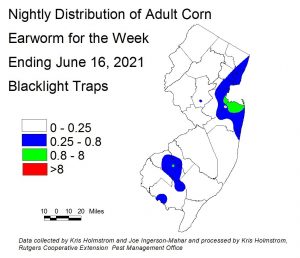 Corn earworm (CEW) moths captures from blacklight traps, while low, continue to occur in a number of locations. As we bring more pheromone traps online, we will use a combination of these trap types to derive silk spray schedules by region. The northernmost pheromone traps are not yet operational. At present, pheromone trap captures have declined from last weeks numbers, but these traps are indicating a more conservative schedule in parts of the state. The number of pheromone traps deployed is much lower, resulting in much broader color bands on the map. It is also important to understand that pheromone traps are more sensitive than blacklight traps, and thresholds are adjusted to account for the higher catches typical of this trap type. Silking corn is at risk of CEW infestation at this time. On the blacklight map, green areas represent a 3-4 day silk spray schedule and blue represents a 4-5 day schedule. On the pheromone map, red represents a 3-day schedule and green represents a 4-5 day schedule. Be sure to access information from this publication in the upcoming weeks to determine how frequently you should treat silking sweet corn to protect it from CEW infestation.
Corn earworm (CEW) moths captures from blacklight traps, while low, continue to occur in a number of locations. As we bring more pheromone traps online, we will use a combination of these trap types to derive silk spray schedules by region. The northernmost pheromone traps are not yet operational. At present, pheromone trap captures have declined from last weeks numbers, but these traps are indicating a more conservative schedule in parts of the state. The number of pheromone traps deployed is much lower, resulting in much broader color bands on the map. It is also important to understand that pheromone traps are more sensitive than blacklight traps, and thresholds are adjusted to account for the higher catches typical of this trap type. Silking corn is at risk of CEW infestation at this time. On the blacklight map, green areas represent a 3-4 day silk spray schedule and blue represents a 4-5 day schedule. On the pheromone map, red represents a 3-day schedule and green represents a 4-5 day schedule. Be sure to access information from this publication in the upcoming weeks to determine how frequently you should treat silking sweet corn to protect it from CEW infestation.
The highest nightly blacklight trap catches of CEW for the week ending 6/16/21 are as follows:
| Matawan 4 | Crosswicks 1 | Hillsborough 1 |
| Allentown 1 | Downer 1 | Jones Island 1 |
| Bellemeade 1 | Farmingdale 1 | Pennington 1 |
| Centerton 1 | Hackettstown 1 | Sergeantsville 1 |
The highest nightly pheromone trap catches of CEW for the week ending 6/16/21 are as follows: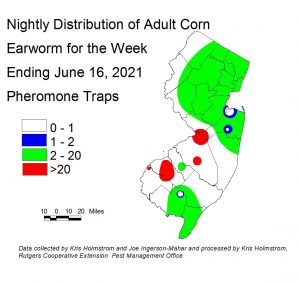
| Crosswicks 27 | Elm 18 | South Branch 8 |
| Monroeville 27 | Woodstown 17 | Eldora 7 |
| Tabernacle 22 | Beckett 15 | Dayton 4 |
| Pedricktown 20 | Green Creek 10 | Farmingdale 1 |
Silking Spray Schedules*:
South – 4 days
Central – 4-5 days
North – 5-6 days
*These recommendations are based on regional catches. Adhere to tighter spray schedules if indicated by local trap catches. Synthetic pyrethroids alone should NOT be used for corn earworm (CEW) protection on silking corn, or for fall armyworm (FAW) management at any stage. Control with these materials is very inconsistent.
Tomatoes
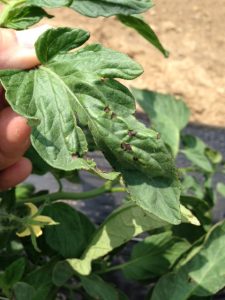 Bacterial leaf spot (BLS) symptoms have begun to appear in a few northern NJ tomato fields. Symptoms of this infection include small, very dark lesions appearing on foliage of any age (see photo at left). Often even immature, unexpanded leaves are affected. Copper resistance in BLS populations in NJ has been identified. Please refer to Dr. Andy Wyenandt’s post of 5/28 regarding bacterial leaf spot of tomatoes and peppers for further information on this important disease of these crops.
Bacterial leaf spot (BLS) symptoms have begun to appear in a few northern NJ tomato fields. Symptoms of this infection include small, very dark lesions appearing on foliage of any age (see photo at left). Often even immature, unexpanded leaves are affected. Copper resistance in BLS populations in NJ has been identified. Please refer to Dr. Andy Wyenandt’s post of 5/28 regarding bacterial leaf spot of tomatoes and peppers for further information on this important disease of these crops.
Peppers
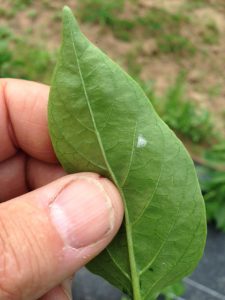 With ECB moth activity continuing, growers should be looking for ECB egg masses (see photo at left) on the underside of pepper leaves. The larvae that hatch from these eggs will bore into the central stem of pepper plants in the absence of suitable fruit. This damage causes the tops of the plant to die, and eliminating the crown set of fruit in the process. Check 2 leaves per plant on 5 consecutive plants in 10 random locations. Consider treating if 2 or more leaves are found to have ECB larvae on the lower surface.
With ECB moth activity continuing, growers should be looking for ECB egg masses (see photo at left) on the underside of pepper leaves. The larvae that hatch from these eggs will bore into the central stem of pepper plants in the absence of suitable fruit. This damage causes the tops of the plant to die, and eliminating the crown set of fruit in the process. Check 2 leaves per plant on 5 consecutive plants in 10 random locations. Consider treating if 2 or more leaves are found to have ECB larvae on the lower surface.
Phytophthora crown rot has begun to appear in some fields following warm temperatures and high soil moisture. Look for clusters of wilting plants (photo at right). Inspect the stem near the soil line. If a black lesion is present, it 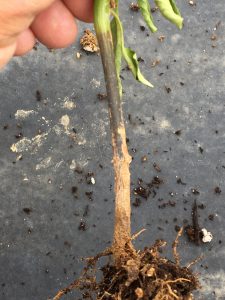 is likely that Phytophthora is responsible (photo at left). Please see Dr. Andy Wyenandt’s post of 5/30/21 regarding Phytophthora management.
is likely that Phytophthora is responsible (photo at left). Please see Dr. Andy Wyenandt’s post of 5/30/21 regarding Phytophthora management.
Pepper weevil – Pheromone traps continue to be set out across southern New Jersey. As yet, no weevils have been trapped. A new fact sheet is now available for anyone interested in monitoring for pepper weevils on their own: FS1330: Monitoring and Management of Pepper Weevil in New Jersey (Rutgers NJAES).
Potato Leafhopper
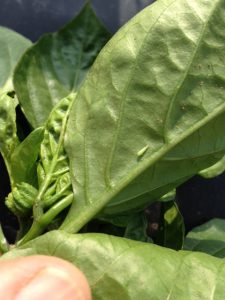 Potato leafhopper (PLH) adults (see photo at left) have appeared in snap beans and other crops over the past week. This pest is a particular problem because it often goes unnoticed until foliar distortion and burn occurs. Once this damage appears in beans and some potato varieties, yields have already been compromised. It is critical that beans be monitored regularly for the presence of PLH. If a sweep net is available, consider treating if more than 100 nymphs and adults are present in 20 sweeps of pre-bloom stage plants. This threshold increases to 250 during bloom and to 500 per 20 sweeps during pod development. If no sweep net is available, check plants in 10 random field locations and consider treating if adults and nymphs are found throughout. Adults are pale green, and will fly out from foliage when disturbed and immediately fly back into the plant canopy. Nymphs are wingless and bright green and may be found on the underside of leaves.
Potato leafhopper (PLH) adults (see photo at left) have appeared in snap beans and other crops over the past week. This pest is a particular problem because it often goes unnoticed until foliar distortion and burn occurs. Once this damage appears in beans and some potato varieties, yields have already been compromised. It is critical that beans be monitored regularly for the presence of PLH. If a sweep net is available, consider treating if more than 100 nymphs and adults are present in 20 sweeps of pre-bloom stage plants. This threshold increases to 250 during bloom and to 500 per 20 sweeps during pod development. If no sweep net is available, check plants in 10 random field locations and consider treating if adults and nymphs are found throughout. Adults are pale green, and will fly out from foliage when disturbed and immediately fly back into the plant canopy. Nymphs are wingless and bright green and may be found on the underside of leaves.
Cucurbit Downy Mildew
A cucurbit downy mildew sentinel plot is now established at Snyder Farm in Hunterdon County. This plot, consisting of pumpkin, watermelon, cantaloupe, butternut, acorn, cucumber and kabocha squash will be used to indicate the presence of cucurbit downy mildew in the region, and what crops are affected. For regional information on this important disease, see the Cucurbit Downy Mildew Forecast webpage: http://cdm.ipmpipe.org/.
Brown marmorated stink bug (BMSB)
Cooler evening temperatures have resulted in lower BMSB activity and extremely low trap catches. No map will appear in this addition.
